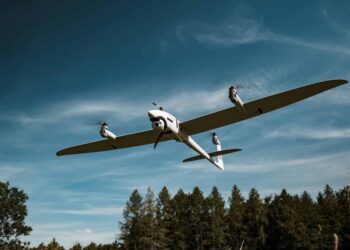, WASHINGTON: The MV-22 Osprey has accomplished two major steps required for initial operational capability (IOC) with completion of a major Block B operational test period and a successful IOC Supportability Review pre-board, program officials announced at a press conference April 4.
Col. Mathew Mulhern, V-22 Osprey Joint Program Manager, and Gene Cunningham, Bell Boeing V-22 Deputy Program Manager, briefed reporters at the Navy League Sea-Air-Space Expo in Washington on the MV-22’s progress toward combat readiness. The Marine Corps’ tiltrotor is expected to earn the go-ahead this summer for operational deployment, bolstered in part by the aircraft’s high performance under mission-representative testing in February and March.
Marine Tiltrotor Test and Evaluation Squadron 22 (VMX-22) put the Block B Osprey – the combat configuration of the aircraft – through its paces for that evaluation period, known to testers as OT-IIIA. Crews completed 120 Block B flight hours and an additional 65 hours on Block A aircraft, in real-world scenarios over 18 days in the California and Arizona deserts. Crewmembers from Marine Medium Tiltrotor Squadron 263 (VMM-263) and Marine Medium Tiltrotor Training Squadron 204 (VMMT-204) also participated.
“Although the official test report won’t be issued until later this month, initial results tell us that the Osprey really showed its full potential, both in terms of mission performance and reliability,” Mulhern says. Block B improvements for the Bell Boeing tiltrotor include the Ramp Mounted Weapon System, retractable refueling probe, personnel hoist and fast rope system, mission auxiliary tanks, and numerous reliability and maintainability upgrades.
“The aircraft did very well. We were actually above our normal mission-capable averages for those three weeks,” says Lt. Col. Denny Sherwood, VMX-22 aircraft maintenance officer. Maintenance resources and supplies were all in keeping with standard deployment planning, he says. “We had the aircraft we needed to accomplish all the missions despite the high op tempo.”
Those missions included a 2,100 mile self-deployment, assault raids, company insertions, recon insertions and extractions, casualty evacuations, tactical recovery of aircraft and personnel, noncombatant evacuation operations, and battlefield logistics. Missions involved fast rope and personnel hoist operations, external lift of the M777 Lightweight Howitzer, 1,200 rounds fired from the Ospreys’ M-240D ramp-mounted machine guns, and 22 aerial refuelings. A third of the flying was done at night, including eight aerial refuelings.
Crews faced multiple ground threats day and night, to validate and refine the tactics, techniques and procedures for objective area entry and threat reaction. They also integrated their operations with F/A-18 Hornets, AV-8 Harriers and AH-1 Cobras. For troop delivery and recovery missions, the MV-22s carried 22 to 24 Marines, along with their gear. Average mileage per mission was 725 nautical miles, with the four VMX-22 aircraft logging a total of 30,000 miles during the evaluation period.
“We absolutely went out there and operated in a very operationally representative manner,” says VMX-22 Commanding Officer Col. Keith Danel. “You name it, we did it, and the aircraft held up very well. And we operated it in a gritty, windy, austere environment, and maintained a very high tempo.”
The Marine Corps has extensive experience operating the Osprey in the desert, and Sherwood said many maintenance lessons have been learned along the way. Besides prior operational testing in the desert in 2004 and 2005, Marine Medium Tiltrotor Squadron 263 (VMM-263) completed an extended training deployment to Naval Air Facility El Centro, Calif., in September and October 2006.
Operating under deployed conditions in the sand, squadron maintainers generated mission capable rates with their Block B Ospreys on par with goals for actual deployment.
“We know that if the Osprey deploys to the desert, it’s going to see the same increased wear and tear that the every other aircraft sees over there. So we’ve planned our logistics support accordingly,” Mulhern says.
On March 23, the Osprey program earned a passing grade on its logistics support plans for first deployment from the final IOC Supportability Review pre-board, which has convened every six months over the last two years to track logistics planning.
“It’s not enough to give a capable aircraft system to the operators. You have to deliver it with all the support necessary to keep those aircraft up and flying over the long haul, whenever and wherever they’re needed,” says Mulhern.
The IOC Supportability Review board membership includes the Second Marine Aircraft Wing, Commander Naval Air Forces, Marine Forces Command, the Naval Air Systems Command, Naval Inventory Control Point and other key agencies. Their endorsement will be a required precursor for the Marine Corps to declare the Osprey ready for deployment. That decision is expected this summer, following a positive OT-IIIA report and final capability additions to VMM-263’s Block B Ospreys.
Beyond the positive performance of the aircraft and identification of remaining corrective action items, Danel says OT-IIIA has larger implications for validating the acquisition strategy adopted by the Marine Corps and Program Office for the MV-22. He points out that while the formal Block B operational test period has only just concluded, individual Block B capabilities have been tested incrementally over the last year and delivered to the Fleet for training and integration as soon as they were cleared.
“We’ve produced interim assessment reports on capabilities as they’ve been available. … In the old acquisition system, we would have done OT-IIIA and then cleared the Fleet to fly Block B. Because we’ve released capabilities as they’ve been tested, the squadrons are nine months to a year ahead of where they would have been. It really speaks volumes about the successfulness of spiral development, spiral testing and interim reporting.”
“It’s up to the Marine Corps and the Department of Defense to decide when and where to deploy this aircraft,” Mulhern said. “But we’re committed to ensuring they have the capability they need and all the support to employ it anywhere in the world.”
Germany says adding explosive drones to weapons arsenal
Germany said Friday it would buy explosive drones for the first time as Berlin boosts investments in its armed forces...









